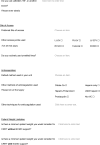Provision of continuous renal replacement therapy in children in intensive care in Australia and New Zealand
- PMID: 39781495
- PMCID: PMC11704422
- DOI: 10.1016/j.ccrj.2024.08.007
Provision of continuous renal replacement therapy in children in intensive care in Australia and New Zealand
Abstract
Objectives: The objective of this study was to describe current use, clinical practice, and outcomes of continuous renal replacement therapy (CRRT) in children in the intensive care unit (ICU) in Australia and New Zealand.
Design: retrospective, binational registry-based cohort study and electronic survey of clinical practice.
Setting: ICUs that contribute to the Australian and New Zealand Paediatric Intensive Care Registry and a survey conducted in November 2021 including ICUs accredited for paediatric intensive care training that provide CRRT for children were part of this study.
Participants: Patients aged <18 years who received renal replacement therapy (RRT) in the ICU were included. Analysis of Australian and New Zealand Paediatric Intensive Care Registry data encompassed admissions from 1 January 2016 to 31 December 2020.
Interventions: None.
Results: 1378 of 58,736 (2.4%) ICU admissions received RRT (CRRT or peritoneal dialysis [PD]), of which 592 (1.0%) received CRRT. Patients receiving CRRT were older and had a median age of 43 months (interquartile range: 7-130 months) compared to 0.3 months (interquartile range: 0.1-2.6 months) for PD. CRRT was used more commonly in all patient groups (523/626, 84%), except those with congenital heart disease (CHD). The number of admissions receiving CRRT varied between units from 1 to 160 admissions for the 5-year period. Overall ICU mortality for CRRT was 30% (175/592). ICU mortality was the highest in neonates ([51/108] 47%) and in those with CHD ([40/69] 58%). ICU mortality for CRRT decreased over the 5-year study period (35%-22%, p = 0.025). The survey showed consistency in CRRT equipment used between units, but there were differences in choice of dialytic modality and anticoagulation regimen.
Conclusion: CRRT is used less frequently than PD in smaller children and in those with CHD. In all other cohorts, it is the predominant mode of RRT. ICU mortality rates were higher for CRRT than for PD, with a large variation in mortality rates across age and diagnostic groups. The CRRT mortality in ICU decreased over the 5 years of the study.
Keywords: Continuous renal replacement therapy; Intensive care; Outcomes; Paediatric intensive care; Paediatrics.
© 2024 Published by Elsevier B.V. on behalf of College of Intensive Care Medicine of Australia and New Zealand.
Figures





References
-
- Kellum J.A., Lameire N., Aspelin P., Barsoum R.S., Burdmann E.A., Goldstein S.L., et al. Kidney disease: improving global outcomes (KDIGO) acute kidney injury work group. KDIGO clinical practice guideline for acute kidney injury. Kidney Int Suppl. 2012;2:1–138.
-
- Fleming G.M., Walters S., Goldstein S.L., Alexander S.R., Baum M.A., Blowey D.L., et al. Nonrenal indications for continuous renal replacement therapy: a report from the prospective pediatric continuous renal replacement therapy registry group. Pediatr Crit Care Med. 2012;13 - PubMed
-
- Ronco C., Garzotto F., Brendolan A., Zanella M., Bellettato M., Vedovato S., et al. Continuous renal replacement therapy in neonates and small infants: development and first-in-human use of a miniaturised machine (CARPEDIEM) Lancet. 2014;383:1807–1813. - PubMed
-
- Coulthard M.G., Crosier J., Griffiths C., Smith J., Drinnan M., Whitaker M., et al. Haemodialysing babies weighing <8 kg with the Newcastle infant dialysis and ultrafiltration system (Nidus): comparison with peritoneal and conventional haemodialysis. Pediatr Nephrol. 2014;29:1873–1881. - PMC - PubMed
LinkOut - more resources
Full Text Sources

